
Arp 271 is a pair of similarly sized interacting spiral galaxies, NGC 5426 and NGC 5427, in the constellation of Virgo. It is not certain whether the galaxies are going to eventually collide or not. They will continue interacting for tens of millions of years, creating new stars as a result of the mutual gravitational attraction between the galaxies, a pull seen in the bridge of stars already connecting the two. Located about 130 million light-years away, the Arp 271 pair is about 130,000 light-years across. It was originally discovered in 1785 by William Herschel. It is speculated, that the Milky Way will undergo a similar collision in about five billion years with the neighbouring Andromeda Galaxy, which is currently located about 2.6 million light-years away.

NGC 5806 is an intermediate spiral galaxy in the constellation Virgo. It was discovered on February 24, 1786, by the astronomer John Herschel. It is located about 70 million light-years away from the Milky Way. It is a member of the NGC 5846 Group.

NGC 51 is a lenticular galaxy in the constellation Andromeda. It has a diameter of 90,000 light-years. The galaxy was discovered on September 7, 1885, by Lewis Swift, who described it as "Pretty faint, pretty small, round, brighter middle."
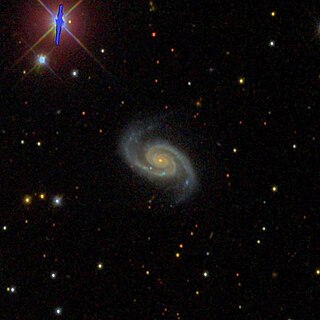
NGC 6560 is a spiral galaxy located in the constellation Hercules. It was discovered by Lewis A. Swift on 22 October 1886.
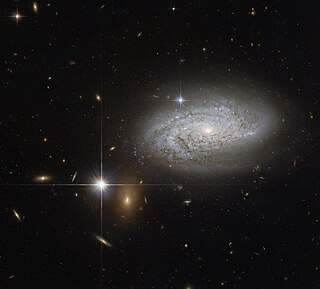
NGC 3021 is a spiral galaxy in the northern constellation of Leo Minor. It is about 93 million light-years away from Earth, and is receding with a heliocentric radial velocity of 1,537±4 km/s. This galaxy was discovered December 7, 1785 by Anglo-German astronomer William Herschel. The morphological classification of NGC 3021 is SA(rs)bc, which indicates a spiral galaxy with no central bar (SA), an incomplete inner ring structure (rs), and moderate to loosely wound spiral arms (bc).
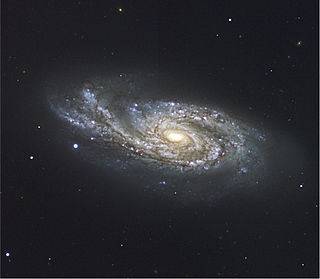
NGC 908 is an unbarred spiral galaxy in the constellation Cetus. It was discovered in 1786 by William Herschel. This galaxy is 56 million light years away from Earth. It is the main galaxy in the NGC 908 group, which also includes NGC 899, NGC 907, and IC 223.
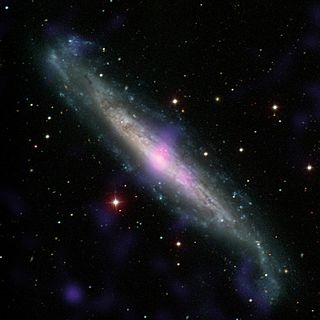
NGC 1448 or NGC 1457 is an unbarred spiral galaxy seen nearly edge-on in the constellation Horologium. It is at a distance of 55 million light years from Earth. It was discovered by John Herschel in 1835.
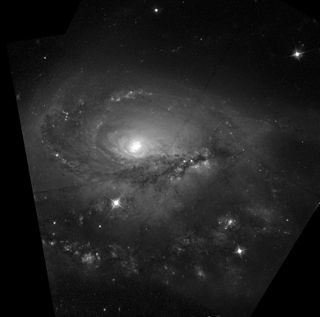
NGC 1961 is a spiral galaxy in the constellation Camelopardalis. It was discovered by William Herschel on 3 December 1788. It is at a distance of about 200 million light years from Earth, which, given its apparent dimensions, means that NGC 1961 is more than 220,000 light years across. The galaxy has been distorted, however no companion has been detected nor double nuclei that could show a recent merger. Its outer arms are highly irregular. Two long straight arms extent from the north side of the galaxy. A luminous X-ray corona has been detected around the galaxy. NGC 1961 is the central member of the small group of nine galaxies, the NGC 1961 group.

NGC 298 is a spiral galaxy in the constellation Cetus. It was discovered on September 27, 1864 by Albert Marth. NGC 298 is situated close to the celestial equator and, as such, it is at least partly visible from both hemispheres in certain times of the year. Given its B magnitude of 14.7, NGC 298 is visible with the help of a telescope having an aperture of 20 inches or more.

NGC 304 is a lenticular galaxy in the constellation Andromeda. It was discovered on October 23, 1878, by Édouard Stephan.
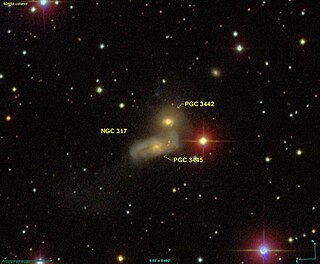
NGC 317 is a pair of interacting galaxies, consisting of a lenticular galaxy NGC 317A and a spiral galaxy NGC 317B, in the constellation Andromeda. It was discovered on October 1, 1885 by Lewis Swift.
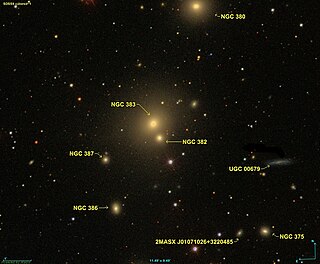
NGC 382 is an elliptical galaxy located in the constellation Pisces. Its discovery has been credited to William Parsons.

NGC 3506 is a spiral galaxy in the constellation Leo. It is located at a distance of circa 300 million light years from Earth, which, given its apparent dimensions, means that NGC 3506 is about 115,000 light years across. The galaxy has two main spiral arms, with high surface brightness, which can be traced for half a revolution before they fade. One arm splits into four spiral arcs.
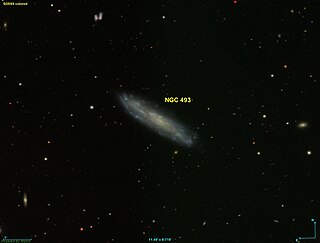
NGC 493, also occasionally referred to as PGC 4979 or GC 281, is a barred spiral galaxy in the constellation Cetus. It is located approximately 90 million light-years from Earth and was discovered on December 20, 1786 by astronomer William Herschel. It was later also observed by his son, John Herschel. John Dreyer, creator of the New General Catalogue, described the galaxy as "very faint, large, much extended 60°" with "a little brighter middle".

NGC 5018 is an elliptical galaxy located in the constellation of Virgo at an approximate distance of 132.51 Mly. NGC 5018 was discovered in 1788 by William Herschel.

NGC 5468 is an intermediate spiral galaxy located in the constellation Virgo. It is located at a distance of about 140 million light-years from Earth, which, given its apparent dimensions, means that NGC 5468 is about 110,000 light-years across. It was discovered by William Herschel on March 5, 1785.
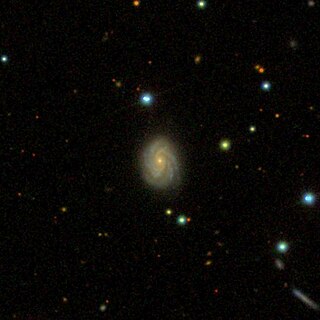
NGC 819 is a spiral galaxy approximately 302 million light-years away from Earth in the constellation of Triangulum. It forms a visual pair with the galaxy NGC 816 5.7' WNW.
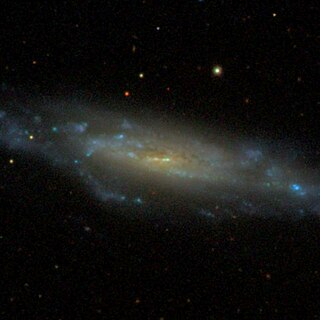
NGC 3003 is a nearly edge-on barred spiral galaxy in the constellation of Leo Minor, discovered by William Herschel on December 7, 1785. It has an apparent visual magnitude of 11.78, at a distance of 19.5 Mpc from the Sun. It has a recessional velocity of 1474 km/s.

NGC 1325 is a flocculent spiral galaxy situated in the constellation of Eridanus. Located about 75 million light years away, it is a member of the Eridanus cluster of galaxies, a cluster of about 200 galaxies. It was discovered by William Herschel on 19 December 1799.

NGC 4589 is an elliptical galaxy located in the Draco constellation. It is at a distance of about 108 million light-years away from the Earth. It is known by its designations PGC 42139 or UGC 7797.




















